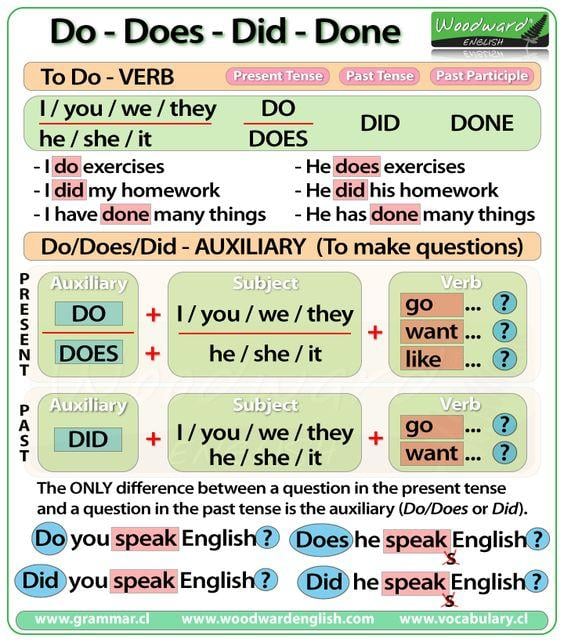The word "do" comes up a lot in English. This is because it can be used in a variety of ways and tenses. Let’s look at each one in more detail below.

TO DO – Present Tense
With the verb "to do" in the Present Tense…
We say: I do / you do / we do / they do
But we say: he does / she does / it does
For example:
- I do my laundry on Saturdays.
- They do their homework when they arrive home from school.
- He does nothing all day.
- She does her best every day at work.
TO DO – Past Tense
The simple past tense of "do" is "did" for all subjects:
I did / you did / we did / they did / he did / she did / it did
- He did a magic trick.
- The dog did a spin.
- I did my homework in my bedroom.
- She did ballet after school last year.
TO DO – Past Participle
The past participle of "do" is "done". It's important to remember that past participles are accompanied by a conjugation of the verb "to have" or "to be".
In general "have + past participle" is used with a perfect tense and "be + past participle" is with the passive voice.
Let’s look at some examples:
- I have done my homework.
- He has done a good job.
These two sentences are in the present perfect tense because they have "have" or "has" before the past participle "done".
- The video will show you how it is done.
- The report was done on time.
In the two examples above, the conjugation of the verb "to be" is used before the past participle done. This indicates that the sentence is in the passive voice.
TO DO – To replace a verb
Sometimes the verb "do" can be used to replace a verb when the meaning is clear or obvious. This replacement is more common in informal and spoken English:
Have you done the laundry yet?
I’ll do the kitchen if you do the lawns.
DO / DOES / DID – For Questions
To make a question in the simple present tense in English we normally put the auxiliary "do" or "does" and for questions in the past tense "did" at the beginning of the question before the subject.
Look at this affirmative sentence:
- You speak English.
How can we turn this into a question? We add "do" at the beginning so it becomes:
- Do you speak English?
Another example would be:
- He speaks Korean.
To make this a question we say:
- Does he speak Korean?
For sentences in the past tense, it works very similar:
- You lived in France.
How can we make this a question? We add "did" at the beginning so it becomes:
- Did you live in France?
As you an see, the only difference between a question in the present tense and the past tense is when it refers to third person (he, she, or it) is the first part… "does" or "did".
DO and DOES – For Emphasis
Sometimes "do", "does" and "did" are used in positive sentences to give special emphasis that what you say is true, despite what the other person thinks. Note that when speaking, the word (do/does/did) is stressed with the voice.
For example:
- I do really want to go.
- I did study for the test.
One thing to note here is that "did" is used for positive sentences in the past tense and that the main verb is in its base form.
Are you interested in teaching English as a foreign language?
Get your TESOL certification with ITTT.
Register now & get certified to teach english abroad!


